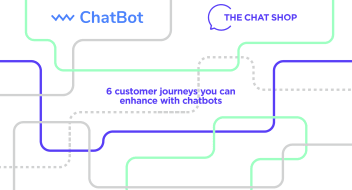Showing top 0 results 0 results found
Showing top 0 results 0 results found
Chatbot Interactions: The Key to Seamless User Engagement and Support

I’m assuming that you’re familiar with the topic of chatbots. Nevertheless, if you want to supplement your knowledge before reading further - here are some articles that will help you better explore the topic:
- The Essential Chatbot Terminology for Beginners
- All You Need to Know is to Use Chatbots in Business. Complete Guide
🤖 Have too many customer questions to answer on your plate?
What are chatbot interactions?
They're the conversations users have with chatbots, crucial in enhancing user engagement and providing support. Chatbot interactions are the back-and-forth exchanges between website users and these intelligent virtual assistants to give the best possible customer service and thus deliver the best customer experience.
They are designed to simulate human conversation, allowing users to ask questions, seek assistance, or complete tasks seamlessly. The significance of chatbot communication lies in their ability to engage users in a personalized and interactive manner while providing valuable support and guidance.
Chatbot interactions offer a convenient and efficient way to enhance user experiences and address their queries or concerns by understanding user needs and delivering relevant responses. As you might expect, those robot-to-human conversations are inevitable in customer service chatbots.
Types of chatbot interactions
Let's look at the various chatbot interactions that make these virtual assistants versatile and valuable. Within the realm of chatbots, we'll explore five distinct types of interactions:
A. Quality assurance interactions
These interactions are a fundamental role that chatbots play in addressing user queries. Acting as knowledgeable assistants, chatbots provide information and solutions to user questions. They employ information retrieval and response generation techniques to guarantee accurate and timely responses. The most typical use case is messaging apps such as Facebook Messenger. Self-service without a live agent!
B. Task-based interactions
In this case, the interactions involve chatbots assisting humans in completing specific tasks. These tasks can range from making reservations to ordering products. Chatbots integrate with external systems and utilize APIs to execute these tasks on behalf of the users, streamlining the process, providing convenience, and once again improving the customer experience.
C. Recommendation interactions
These interactions leverage chatbots to offer personalized recommendations based on user preferences. Chatbots generate relevant product, service, or content suggestions by analyzing user behavior and data. The algorithms and techniques guarantee that the recommendations align with the user's interests and enhance their overall experience.
D. Support interactions
Chatbots can serve as virtual support agents, providing assistance and guidance to users. In support interactions, chatbots troubleshoot issues, offer step-by-step instructions, and provide relevant resources or documentation. They aim to address user concerns efficiently and effectively.
E. Conversational interactions
Finally - these interactions focus on engaging users in natural conversations. Chatbots utilize advanced natural language processing (NLP) techniques to understand user inputs and respond accordingly thanks to a statistical language model. These interactions simulate human-like conversations, allowing users to engage in small talk, seek advice, or share feedback, enhancing the overall customer experience.
The versatility of chatbot interactions contributes to their effectiveness in engaging users and providing valuable assistance.
The benefits and challenges of chatbot interactions
With the above interaction types in mind, you can deduce in what spheres they can be helpful. So let's summarize all their benefits.
Firstly, they enhance user engagement and satisfaction by providing personalized and relevant responses. Chatbots keep users hooked by delivering information, assistance, and tailored recommendations.
Secondly, chatbot interactions bring efficiency to support and assistance processes and handle repetitive tasks. With quick and automated responses, chatbots can handle many queries simultaneously, providing timely assistance. Self-service at its finest!
However, chatbot interactions also come with their own set of challenges. One key challenge is accurately understanding user intent in conversation. Interpreting user queries and requests correctly guarantees that chatbots provide appropriate responses.
Best practices for designing chatbot interactions
Specific best practices can elevate their effectiveness and the user experience when designing chatbot interactions. First and foremost, conversational design principles play a vital role. Designers focus on creating natural and intuitive conversation flows that mimic human interactions, making users feel at ease.
Next, context awareness and personalization are critical. By considering user context, chatbots can offer more relevant and personalized responses, enhancing engagement and satisfaction. Lastly, continuous learning and improvement are essential.
Chatbots should be designed with the capability to learn from user interactions, adapt to changing user needs, and continually improve their responses, ensuring a seamless and evolving experience. Incorporating these best practices leads to well-designed chatbot interactions that users find intuitive, personalized, and continuously improving.
Ensuring ethical and responsible chatbot interactions
As chatbot interactions evolve and become more sophisticated, it is essential to consider this technology's ethical and responsible use. Designers and developers should prioritize transparency and make sure users know they interact with chatbots. Privacy and data security measures must be implemented to safeguard user information.
Moreover, chatbots should be programmed to handle sensitive topics with empathy and respect, avoiding biases and discrimination. You can build trust and foster positive user experiences by promoting ethical practices in chatbot interactions.
Balancing automation and human intervention
While chatbot interactions offer numerous benefits, balancing automation and human intervention is crucial. Chatbots excel at handling routine queries and tasks, but there are situations where human intervention may be necessary.
Incorporating options for a seamless handover to human agents or providing clear channels for escalation guarantees that users receive the assistance they need, especially in complex or emotionally sensitive scenarios. By combining the efficiency of chatbot interactions with the empathy and problem-solving skills of human agents, organizations can deliver exceptional customer experiences.
Case studies and examples
Let's explore real-world examples of successful chatbot interactions implemented by prominent companies across different industries. In the ecommerce sector, Amazon has leveraged chatbot interactions through their virtual assistant, Alexa, enabling users to make voice-based purchases and access personalized recommendations. In healthcare, companies like Infermedica have developed chatbots (in cooperation with us!) that provide COVID-19 symptoms checkers, allowing users to receive medical guidance remotely.
In the travel industry, KLM Royal Dutch Airlines introduced a chatbot called BlueBot, which assists customers with booking flights, providing travel information, and managing their reservations.
These examples highlight how companies like Amazon, Infermedica, and KLM have effectively utilized chatbot interactions to enhance user experiences, streamline processes, and deliver valuable services across various sectors.
Future emerging trends
The future of chatbot interactions holds exciting possibilities. Advancements in natural language processing and artificial intelligence (AI) pave the way for more genuine and human-like interactions. Chatbots are becoming better at understanding context, sentiment, and even nuances in language, making conversations feel more authentic.
Additionally, integration with voice assistants and multi-modal interfaces opens new ways of engaging with chatbots, enabling users to interact through speech, gestures, and more immersive experiences.
🤖 Have too many customer questions to answer on your plate?
Embracing the power of chatbot interactions
Chatbots have proven valuable virtual companions, whether answering queries, completing tasks, providing recommendations, offering help, or engaging in conversations. By incorporating best practices in design and leveraging emerging technologies, you can unlock the full potential of chatbot interactions and provide users with seamless, personalized experiences.



